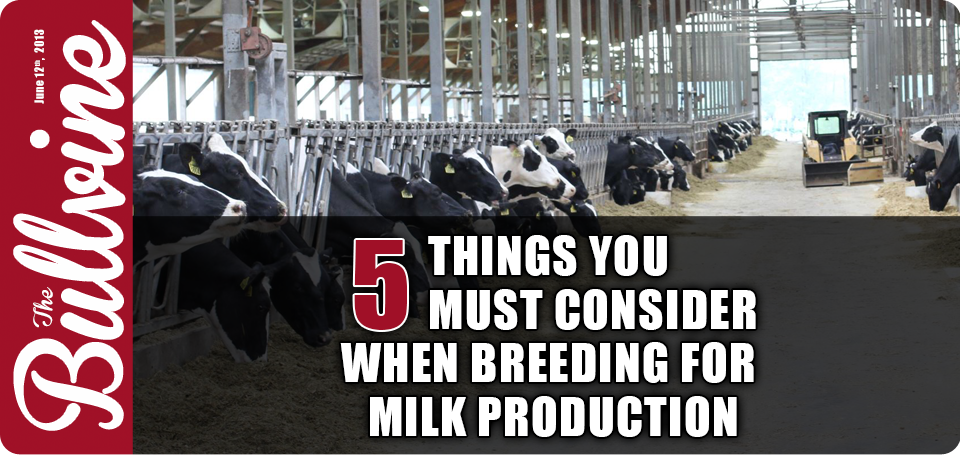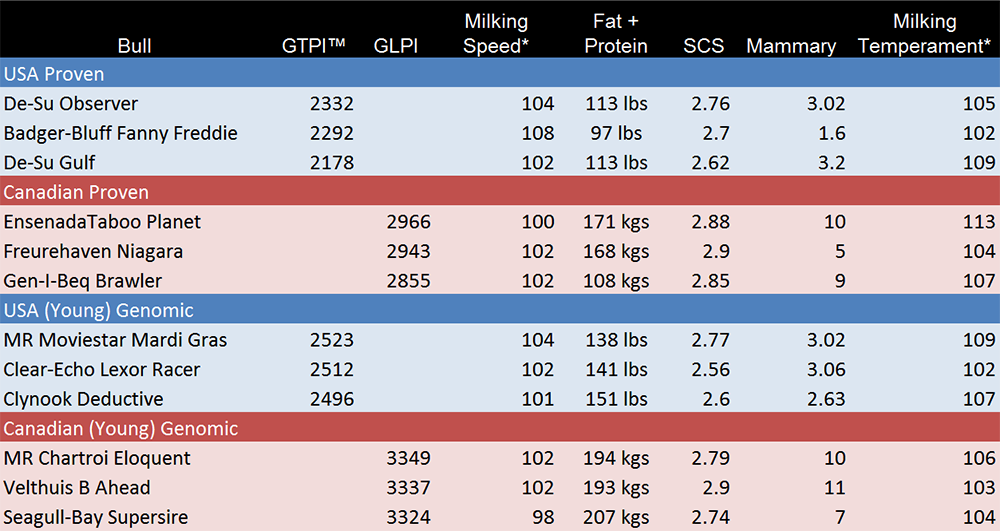Dairy cattle breeders constantly consider indexes for total merit and major traits. However are we ignoring the consideration of traits that most affect us on a daily basis? What I am thinking about are the traits that have a direct bearing on the harvesting of milk. The traits that every milker feels are important as they go about their daily milking routines. Herds are becoming larger, energy is costly, labour is being replaced by technology and product quality must be high. The Bullvine offers the following thoughts for your consideration.
Measuring Milking Speed
Total attachment time of milking units started to be more seriously considered about thirty years ago. Breeders were no longer willing to tolerate cows that took an excessively long time to milk. Researchers in a few countries started by measuring the kgs of milk per minute that a cow yielded and evaluating and ranking sires by the rate at which their daughters milked. This proved to be a costly way of capturing the data when in fact the goal was to identify, eliminate or at least minimize the use of bulls that produced daughters that were very slow milkers. The next move was to have producers categorize first lactation females as slow, average or fast milkers. In time the three categories was expanded to five – very slow, slow, average, fast, and very fast. The heritabilities achieved for these three methods were 0.26 to 0.30 for measured rate, 0.03 to 0.08 for the three category reporting and 0.22 to 0.25 for the five category recording. The end result was that most countries, interested in having sire proofs for milking speed, adopted the five categories reporting system for use in either their linear classification program or milk recording program.
Importance of Milking Speed
The importance breeders place on milking speed often depends on the milking system they use. Farms with tie stall barns have often not worried about milking time except perhaps for very slow cows. But that is changing as labour rates increase and number of cows per milker get much larger. Robotic farms invest heavily in capital costs per cow and the number of cows per robot is tied closely to milking times. To maximize output per robot per day slow cows become a limiting factor. Rotary milk herds may have it easiest when it comes to slow milking cows as they can simply have the cow take a second turn around the rotary. Definitely in parlours milking very slow cows retards the milking process in a major way.
Let’s dig a little deeper. If 5+% of a herd take one minute longer to milk it may only be a concern for managers with parlour systems. However if 5-10 % of the herd take an extra two minutes or more to milk it becomes a concern for all managers. One cow in ten slowing down the milking process by two plus minutes per milking can add many human steps and hours to the work week. What perhaps used to be tolerated for slow milking cows is definitely becoming a thing of the past. One in ten very slow milkers, in the Canadian genetic evaluation system, occurs when a sire is lower than 95 for Milking Speed. In Denmark where 27% of the cows are milked by automated systems, very slow milking cows are a definite no. With today’s high feed and labour costs, it takes well into a cow’s second lactation for her to show a lifetime profit figure. It just does not make economic sense to use sires that produce even ten percent of their daughters that are slow milkers and that must be culled before they even get to positive figures for lifetime profit.
Milking Speed Sire Indexes
In the TPI™, NM$ and LPI total indexing systems milking speed in not included so in sire selection care must be taken not to use sires that are below a rating of 98 in Canada. In the USA national milking speed sire proofs are not calculated so breeders must depend on AI company figures for milking speed or search outside of the USA for figures published on American sires. At the end of the day slow milking cows need to be avoided.
Milk Volume
Breeders usually talk in terms of kgs or pounds of milk per cow per day with an added comment on the % fat and % protein in the milk. However it is, in fact, the daily fat and protein yields per cow that determines revenue. The milk volume is simply the carrier for the fat and the protein. A cow producing 12,000 kgs of milk in 305 days at 3.5%F and 3.0%P produces 420 kgs of fat and 360 kgs of protein. Yet a cow producing 10,000 kgs of milk at 4.2%F and 3.6%P produces exactly the same – 420 kgs of fat and 360 kgs of protein. The milk revenue from each cow will be exactly the same for this 2.56 kgs (5.64 pounds) of fat & protein per day.
But the comparison does not stop at revenue. Factor in that the milk transportation costs are higher for the 12,000 kg cow and that the 10,000 kg cow can likely be fed a more forage based diet. Also think about the less stress and stain, especially on reproduction, with the difference in yield expected per day of 6.6 kgs or 14.4 pounds of milk.
For genetics and selection this means that breeders need to be thinking in terms of the cow or sire with the highest fat plus protein indexes rather than using the milk yield figure. The vast majority of total merit index systems around the world include in their calculation the fat and protein yield numbers instead of the milk volume number but they likely do not factor in the added cost to run farm equipment, transporting the extra water in the milk or to dispose of the waste water from processing plants.
SCS
The production of high quality milk or dairy products is becoming more important with each passing year. Antibiotic residues will no longer be acceptable to our consumers. Cows must be able to produce milk low in somatic cells. Sire proofs and cow indexes for SCS have become well accepted by dairy breeders. Since every drop of milk a cow produces contains somatic cells and since cows usually increase in their somatic cell count as they progress to 3rd and later lactations, it makes little economic sense to have a cow start at 3.00 in her first lactation and then go higher in later lactations.
What this means for genetics and selection is that sires used and the cows that produce the herd replacements need to be below 3.00 and preferably below 2.80 for SCS.
Udder
Breeders and milk producers often may not share the same ‘must haves’ when it comes to udders. While they can agree that the true models are nice, milk producers want udders that are trouble free with enough capacity for the 780 kgs or 1720 pounds of fat plus protein mentioned above. Trouble free would equate to udders held high off the ground and teats of size, shape and position that allow for easy attachment of milking units. Smooth, high and wide attachments to the body are not a priority but udder texture may have some relevance when it comes to the harvesting of milk.
In terms of genetics, udder indexes values above +1.50 UDC or +5 MS will be sufficiently high enough for sires or females used to produce the next generation of females in a herd.
Milking Temperament
Over time cows become accustomed to their environment. Yet not all family bloodlines are the calm easily adaptable to mechanized systems kind of animal. Research has shown that the correlation between excitable first lactation cows and extended milking times is a moderate 0.25. It can be very annoying and time consuming for milking staff to have first lactation cows that do not quickly adapt to milking. This will have more importance in the future as more and more cows are milk automatically.
A number of countries now produce national genetic evaluations for milking temperament. For milk producers wanting a friendly staff-cow-milking environment, they should take care not to use sires or use cows as the dams of herd replacements that are rated much below average for milking temperament.
Bulls to Consider
Based on the factors mentioned above here are some sires the breeders and milk producers may wish to consider in order have their genetics compliment the harvesting of milk on their farms.
Table 1 Sires to Assist with Milking
Note * All sires are listed according to their CDN indexes for Milking Speed & Milking Temperament. USA does not produce indexes.
The Bullvine Bottom Line
One size or one breeding program does not fit all farms. It will be important in the future for breeders and milk producers to have cows that produce high quality milk, that milk out fast, that produce high daily volumes of fat and protein, and that have udders and temperaments that work well within the on-farm systems.
Get original “Bullvine” content sent straight to your email inbox for free.


















Leave a Reply
You must be logged in to post a comment.